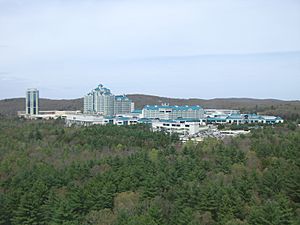Connecticut Indian Land Claims Settlement facts for kids
The Connecticut Indian Land Claims Settlement was an Indian Land Claims Settlement passed by the United States Congress in 1983. The settlement act ended a lawsuit by the Mashantucket Pequot Tribe to recover 800 acres of their 1666 reservation in Ledyard, Connecticut. The state sold this property in 1855 without gaining ratification by the Senate. In a federal land claims suit, the Mashantucket Pequot charged that the sale was in violation of the Nonintercourse Act that regulates commerce between Native Americans and non-Indians.
The settlement act appropriated $900,000 to buy the disputed lands and transferred those lands and the state reservation in trust to the Department of Interior of the federal government. The settlement act permits the state of Connecticut to exercise civil and criminal, but not regulatory, jurisdiction over the lands. Gaining federal recognition and sovereign control of their land enabled the Mashantucket Pequot to develop gaming on their reservation, specifically, the Foxwoods Resort Casino. It is the largest casino in the world by revenue and floor space, and by 2007 was the most profitable. It has struggled financially in the second decade of the 21st century.
Reservation expansion
Starting in 1993, the Pequot began negotiations to purchase additional lands and convey those lands to the Department of Interior in trust under the Indian Reorganization Act of 1934. Local towns sued the tribes to prevent this. In 1996 and 1998, the Interior Department, under Secretary Bruce Babbitt, approved the tribe's request to put 165 new acres (0.67 km2) and 146 new acres (0.59 km2), respectively, into trust. The Supreme Court's decision in Carcieri v. Salazar (2009) prevents any further such transfers.


